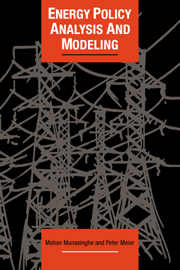Book contents
- Frontmatter
- Contents
- Preface
- List of abbreviations
- PART I Conceptual framework
- PART II Basic techniques
- PART III Subsectoral analysis
- PART IV Sectoral integration
- PART V Implementation
- 13 Institutional arrangements
- 14 Implementing the analytical process
- 15 Case study: Sri Lanka
- 16 Case study: Morocco
- Bibliography
- Index
14 - Implementing the analytical process
Published online by Cambridge University Press: 05 March 2012
- Frontmatter
- Contents
- Preface
- List of abbreviations
- PART I Conceptual framework
- PART II Basic techniques
- PART III Subsectoral analysis
- PART IV Sectoral integration
- PART V Implementation
- 13 Institutional arrangements
- 14 Implementing the analytical process
- 15 Case study: Sri Lanka
- 16 Case study: Morocco
- Bibliography
- Index
Summary
Energy Planning is an on-going process, not a one-time exercise that will provide a permanent policy framework. As such, energy sector planning is no different to planning conducted at the levels above and below it: most implementing institutions in the energy sector – electric utilities, refineries, etc., conduct planning in a regular cycle, with demand forecasts and investment plans typically updated annually. And at the macroeconomic level, many developing countries have five-year planning cycles: but even here policies and investment plans are typically reviewed and updated on an annual basis.
Yet the notion that sector-wide energy planning also needs to be cast as an on-going activity is one that many countries have yet to embrace. Very often the only regular activity is the compilation of historical energy statistics in the form of the ubiquitous Energy Databook. Indeed, in our experience one of the first items on the agenda to establish an on-going energy planning activity is to define a structured staff work program that focusses on the notion of a planning cycle, rather than on aperiodic planning efforts. And only by integrating the work program of the energy planning entity with those of its counterparts can one expect to achieve meaningful progress.
In this chapter we focus on three issues that are central to the implementation of the planning process. The first is the overriding need for consistency, which is perhaps more a matter of dialog with counterpart institutions than a modeling exercise as such.
- Type
- Chapter
- Information
- Energy Policy Analysis and Modelling , pp. 276 - 300Publisher: Cambridge University PressPrint publication year: 1993



